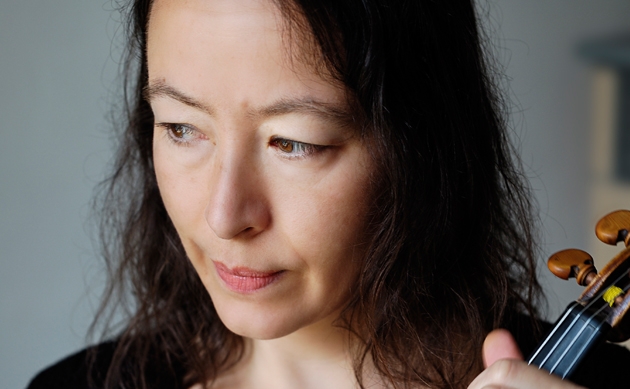
My admiration for Claudia Molitor’s work has grown from a sense of affinity with her quest to examine the relationships between composer, Work, score, performer, environment and audience and from an appreciation of her curiosity to explore the blurred edges between art forms.
I imagine I hear the toot of a toy steam train. No. An ocarina ensemble. No. Wow, those guys can really whistle! A choir singing solemn liturgy. Now accompanied by an organ? No, that’s the voicing. Surely not interrupted by the pop of a champagne bottle? Hold on, Siberian Shamanic throat singers joining the party? Snorting, popping and whistling figures interrupted by a exclamation of surprise, a disappointed sigh and a shocked in-breath.
Within the first three pages of ‘Lorem Ipsum’ (2007) Molitor confounds our expectations. Without recourse to sledge hammer, she turns our pockets of preconceptions inside out with this subtle mischievous piece for SSAATTBB (written for and dedicated to James Weeks, Juliet Fraser and EXAUDI). I love this piece for its charm and attitude, for its wit and attention to colour. I can’t help but listen to the new EXAUDI recording of ‘Lorem Ipsum’ over and over again; it is such a wonderful experience. The performance has a poise and elegance which perfectly suits this gently subversive piece.
Scores such as ‘It Descends Occasionally’ (2006) for Cello (with optional voice) written for Anton Lukoszevieze are feasts for the eyes, indeed, pieces of art in themselves. Meticulously drawn, staves in this score seem to appear from under ripped pieces of paper. A tumble of notes seem to heap onto a yielding stave, notes seem to pass along morphing piping created by staves splitting and twisting, a hand pulls its way out of a stave to tug at the notes above, another hand appears out of the stave to put a stop to the notes at the end. Our internal ears are stimulated to conjure up a vivid performance - bow flurries and flights, strings being brushed, pushed, pulled and hit - the cellist and cello at the heart of the action.

Claudia Molitor - It Descends Occaisionally 2006. P. 4
‘Pink Beads Pop’ (2008) is a delicately scored chamber work for flute, bass clarinet, 2 violins, viola, cello and piano with more of a conventional looking score. The detailed attention to colour and inherent phrasing (as opposed to phrase marks) drew me into this piece and I love the string writing (being a stringer myself) - the rich double-stopped sections, the delicate glissandi, the variety of pizzicato markings. The title of the piece intrigues me - I might well be missing something dead obvious but if I’m not, it seems to be another example of Molitor confounding our expectations!
Countering the expectations she has of her self is something I hugely admire about Molitor’s practice. In the wonderful performance lecture with Jennifer Walshe and Sarah Nicholls at ‘Off The Page’ (2011, Playhouse Theatre, Whitstable.) she describes how she interrupts process in different ways to move towards this goal - writing scores whilst bouncing on a trampoline, writing scores with a pen between toes or with her left hand or with her eyes shut. The same performance lecture is a shining example of Molitor’s interest in the constellation of composer, the Work, performer, environment and audience and her multifarious approach to exploring the interconnectedness of art practices. I hope very much that you’ll enjoy the ongoing discovery of Molitor’s work as much as I do!
© Alison Blunt. June ‘13
Browse works by Claudia Molitor in The Collection
Since a classical violin training at Birmingham Conservatoire and the Guildhall School of Music and Drama, Blunt’s interests have led her to explore the relationships between art forms and genres and to create and perform new work either consisting of or utilising improvisation.
Her activities range from commissions to devise music for film, theatre and contemporary dance to performing within interdisciplinary ensembles; from devising and touring Early Years storytelling performances to performing world folk music; from arranging and recording multicultural songs with activity books for Early Years families and practitioners to concerts with a diverse array of artists in the international improvised, experimental and new music scene. (And that's not the half of it). Alison resists being pigeonholed.
Recent work includes touring Australia and New Zealand with Anglo-Austrian Barcode Quartet, performing with BARREL ("To the uninitiated, this trio of string virtuosos might sound like musical terrorists…revolutionary, funny and breathtakingly audacious." All About Jazz), with Blunt/Taylor/Leahy trio on theMopomoso Tour (produced by Sound and Music), with Burning Wood and with Hanam Quintet, recording and performing with Anglo-Danish Pierette Ensemble, performing and conducting with Berlin Improvisers Orchestra and with London Improvisers Orchestra.
”Alison Blunt’s playing is unique. Eerie, gut-ripping rattles and chokes from hell are interrupted by ringing notes of heavenly hope. I have never heard anything like it…” Jeffery Taylor, Sunday Express 29.1.12
alisonblunt.com
Alison Blunt on Twitter
